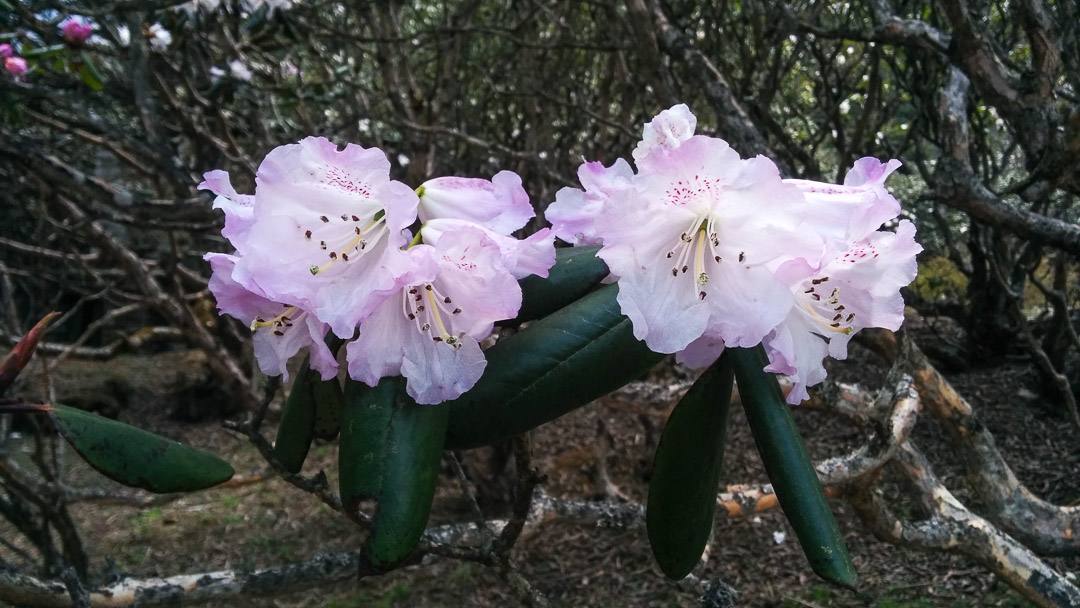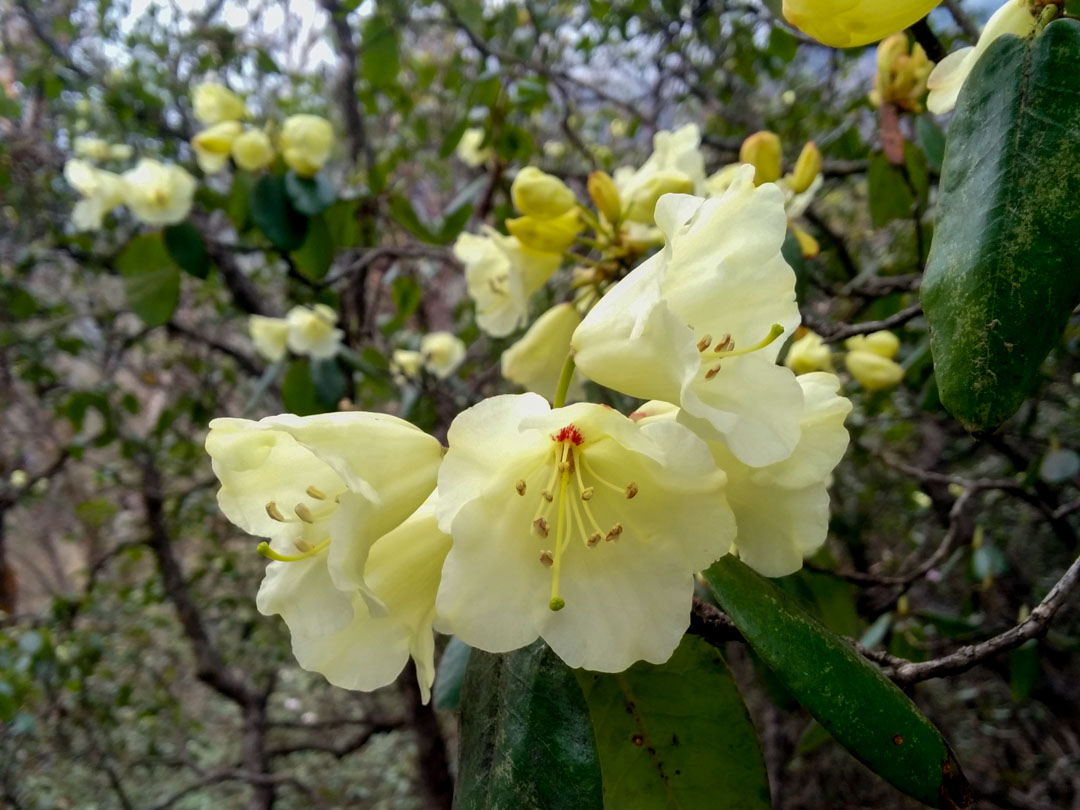
In addition to stunning mountain scenery, the Everest Region also has some amazing flowers. Here are the top fifteen rhododendrons and other flowers you might see when you do the Everest Base Camp Trek.
However, before we start the list, it might help you to know that the best time to visit Everest Base Camp for flowers is from March to May. If you are interested in truly high altitude flowers though, you might have to brave the monsoon rains and do the trek during June/July.
Tree Rhododendron

The Tree Rhododendron is the national flower of Nepal. These big bright red rhododendrons grow on trees that are up to 18 meters high and are quite a sight when the entire tree goes up in flames during spring every year. In addition to being a sight to remember, it is also an important medicinal plant. The petals are eaten raw to cure menstrual disorders, and the bark juice is prescribed in cases of diarrhea and dysentery.
Scientific Name: Rhododendron arboreum
Local Name: Laligurans
Flowering Period: February at 1,500 meters asl to end of May around 3,500 meters asl.
Altitude: 1,500 to 3,500 meters asl.
Best Place to see: Below Tengboche Monastery, Gokyo Valley below Dole, and Phortse.
Barbed-Stalk Rhododendron

This poisonous rhododendron is usually found above 3,000 meters and is the bloodiest red of the rhododendrons. This plant is also the main reason why the springtime honey from the Himalaya can be toxic. While such honey is very seldom fatal, it can result in dizziness, nausea, and temporary motor coordination.
These rhododendrons are differentiated from other rhododendrons by bristles at the base of its flowers.
Scientific Name: Rhododendron barbatum
Local Sherpa Name:
Flowering Period: April-May
Altitude: 2,400 to 3,600 meters asl.
Best Place to see: Below Dole in Gokyo Valley.
Bell Rhododendron

These are one of the few rhododendrons found in pure forests but can also be found in concert with Silver Fir and Juniper. Those forests can appear very jumbled up as the branches and even the trunk grow in all angles. If you happen to be in one of them around May, you will notice that its flowers range from dark purple to white. The thing is the flowers start dark purple and progressively become white with age.
Scientific Name: Rhododendron campanulatum
Local Sherpa Name:
Flowering Period: mid-May to mid-June
Altitude: 3,000 to 4,000 meters asl.
Best Place to see: Namche Bazaar to Khumjung
Curved-Fruit Rhododendron

The word ‘rhododendron’ usually conjures up images of white or red flowers. However, the Curved-fruit Rhododendron is one of the few rhododendrons that has bright yellow flowers. These flowers are usually found in association with the Bell Rhododendron and have a preference for north-west slopes.
Scientific Name: Rhododendron campylocarpum
Local Sherpa Name:
Flowering Period: mid-May to mid-June
Altitude: 3,300 to 4,000 meters asl.
Best Place to see: Namche Bazaar to Khumjung
Three-Flowered Rhododendron

These are another yellow rhododendron that grows on shrubs up to 3 meters high. They are usually found in drier slopes, often with oak trees.
Scientific Name: Rhododendron triflorum
Local Sherpa Name:
Flowering Period: April-May
Altitude: 2,400 to 3,400 meters asl
Best Place to see: between Jorsalle and Namche Bazaar
Bristly Rhododendron

These little pink rhododendrons add a lot of color to high Himalayan pastures during the summer months. The leaves are also used as incense.
Scientific Name: Rhododendron setosum
Local Sherpa Name:
Flowering Period: May to July
Altitude: 3,500 to 4,800 meters asl.
Best Place to see: Pheriche Valley and Gokyo Valley
Dwarf Rhododendron

These little rhododendrons grow on small bushes in high altitude alpine meadows. Its flowers are usually yellow. However, on particularly humid terrain, they can also be pink. The plant is highly aromatic, and its leaves are mixed with juniper for use as incense in Buddhist monasteries. Young and fresh flowers are used to make herbal tea used in liver disorders, allergy, and vomiting.
Scientific Name: Rhododendron anthopogon
Local Sherpa Name: kemba khoru
Flowering Period: June
Altitude: 3,700 to 4,800 meters asl
Best Place to see: Pheriche Valley and Gokyo Valley
Dwarf Snow Rhododendron

Growing in desolate rocky terrains and even next to glaciers and moraines, the Dwarf Snow Rhododendron is one of the hardiest rhododendrons. Its flowers range from pink to light purple and usually blooms in July.
Scientific Name: Rhododendron nivale
Local Sherpa Name:
Flowering Period: June-July
Altitude: 4,500 to 5,500 meters asl.
Best Place to see: Imja Valley
Lily of the Valley

Lily of the Valley is one of the dandiest of plants with its brilliant red young leaves and showy white flowers. These flowers usually grow on shrubs but can often become as big as 5 meters high.
Scientific Name: Pieris formosa
Local Sherpa Name:
Flowering Period: March to May
Altitude: 2,100 to 3,300 meters asl.
Best Place to see: between Lukla and Jorsalle
Anemone Clematis

These guys are early bloomers, and the pretty flowers of these climbers add flair to otherwise drab trees. This plant is also used as one of the components in the local yeast (marcha) used to make homebrews.
Scientific Name: Clematis montana
Local Sherpa Name:
Flowering Period: Apr-May
Altitude: 1800-4000 masl
Best Place to see: Lukla– Namche
Drumstick Primrose

The Drumstick Primrose is one of the most widespread and common species among the primroses. Its perfectly spherical bouquet is quite a sight, especially when there are many plants in one place. Its root powder is used to kill leeches, and the flowers are used to cure stomach disorders.
Scientific Name: Primula denticulata
Local Sherpa Name:
Flowering Period: Apr-Jun
Altitude: 1,500-4,500m
Best Place to see: Below Dingboche/Pheriche, Dole
Kumaon Iris

These beautiful flowers dot grazing grounds and alpine slopes and are often found in large clumps. The flowers show a wide variation in the petal pattern.
The plant can be used as an antidote to opium addiction.
Scientific Name: Iris kemaonensis
Local Sherpa Name:
Flowering Period: Apr-Jul
Altitude: 2800-4000 masl
Best Place to see: Namche-Tengboche
Himalayan Edelweiss

These guys bloom all through the monsoon and some more till about October. The white wooly petals are leaves, and it is only the rounded heads at the center that are the actual flowers.
A close relative of this plant has been the symbol of alpinism in Europe.
Scientific Name: Leontopodium himalayanum
Local Sherpa Name:
Flowering Period: Jul-Oct
Altitude: 3000-4500m
Best Place to see: Pheriche/Dingboche
Spiny Mountain Poppy

This pretty blue poppy with spiny seed has been used as an anti-inflammatory and analgesic drug. Hard to cultivate, these guys are harvested from the wild in large quantities, making them endangered in many places. The plant is also used in lung/skin diseases, headaches, heart problems, blood disorder, bone fracture, back pain, cold, sinusitis, bile disorder, skin problems, and wounds.
Scientific Name: Meconopsis horridula
Local Sherpa Name:
Flowering Period: Jul-Aug
Altitude: 3500-5500m
Best Place to see: Dingboche-Lobuche
Silky Rose

This common and widespread wild rose has beautiful white flowers and bright red edible fruits. And both the flowers and fruits are used in liver, bile, and lung diseases. The flower paste is also used to treat a headache.
Scientific Name: Rosa sericea
Local Sherpa Name: Jangali Gulaf
Flowering Period: May-Aug
Altitude: 2100-4500m
Best Place to see: between Lukla and Jorsalle







